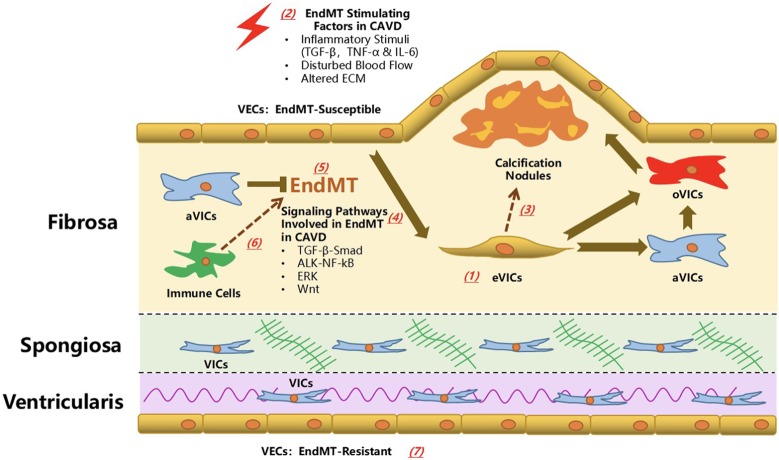Figure 3.
Endothelial-to-mesenchymal transition in calcific aortic valve disease: the known knowledge and unresolved questions. The investigation on the role of endothelial-to-mesenchymal transition (EndMT) in calcific aortic valve disease has recently emerged. The evidence of EndMT in vivo has been found in the fibrosa layer (aortic aspect) of aortic valve, which was distal to the calcification nodule. In vitro evidence supported that inflammatory cytokines (including TNF-α, IL-6 and TGF-β), disturbed blood flow and altered extracellular matrix (ECM) was responsible for the induction of EndMT process, during which the TGF-β-Smad, ALK-NF-kB, ERK and Wnt signaling pathways might play a regulatory role. The transformed VECs (eVICs) might serve as an important reservoir for activated VICs (aVICs) whereas the EndMT process might be negatively regulated by VICs. eVICs might further transformed into an osteogenic type (oVIC) and cooperate with the VIC-derived oVICs to promote the CAVD progression. Several key unresolved questions are crucial in understanding the role of EndMT process in CAVS. (1) The origin of cells co-expressing endothelial and mesenchymal markers in the diseased aortic valve has to be further validated. (2) What are the effects of other risk factors/stimulating factors of CAVD on the EndMT process? (3) The relationship between EndMT process and calcific and osteogenic process remains to be explored in the future. In other words, it is elusive that how the EndMT process contributes to the different phases of CAVD from valve thickening, stenosis to calcification. (4) Several other well-known signaling pathways involved in the regulation of EndMT/EMT might also exert effects on the development of CAVD via EndMT. (5) Further in-depth investigation is required to verify a clearer correlation between the extent of EndMT, and severity and progression of CAVD based on pathological examination and echocardiography evaluation. (6) It is not clear how the interactions between VECs and other immune cells influence the EndMT process, and vice versa. (7) Last but not least, it is worthwhile of intensive efforts to verify the sub-population of EndMT-resistant VECs and the mechanisms modulating this obvious heterogeneity.

